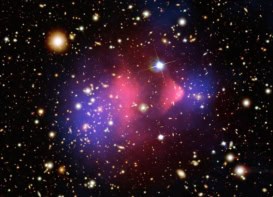
The mysterious excess of high-energy positrons detected by the PAMELA satellite does not come from the two nearby pulsars, according to an international team of physicists using the High Altitude Water Cherenkov Gamma-Ray Observatory (HAWC) in Mexico. The finding opens the door to alternative explanations of the origins of the particles – including the possibility that they are created by the annihilation or decay of dark-matter particles.
The mystery started back in 2008, when scientists at PAMELA – the first satellite detector orbiting in space searching for antimatter – reported detecting an unexpectedly high number of high-energy positrons.
Since then, two plausible explanations for these observations have been debated by physicists. One possibility is that the positrons come from nearby pulsar wind nebulae, which are fast-spinning neutron stars that act as cosmic ray accelerators and produce streams of electrons and positrons. The other possibility is that the positrons are produced by hitherto unobserved processes involving nearby dark matter.
Murky cloud
The two best pulsars candidates are Geminga and PSR B0656+14, because of their age and proximity. However, by looking at gamma rays from the regions around these two pulsars, the HAWC team concluded that both pulsars are surrounded by extended and murky clouds, which positrons cannot pass through to reach Earth. While this appears to rule out the pulsars, it does not prove that the positrons have dark-matter origins.
“[The new result] constrains the pulsar explanation, which was the best… until now,” says Piergiorgio Picozza of the University of Rome Tor Vergata, who was part of the PAMELA team.
“The simplest explanation has disappeared and dark matter remains on the table, maybe gaining some extra points,” adds Picozza. “The community will now have to enter into a big discussion, which for us, is a good thing.”
Andrés Sandoval of the National Autonomous University of Mexico is HAWC’s Mexico spokesperson, and was involved in the research. He did not expect to rule out the pulsars when HAWC started its measurements. “I was very surprised at first, since we really thought they were [the sources],” he tells Physics World.
Questions remain
However, Sandoval says he would not put his money on the dark matter explanation just yet – even though, admittedly, it would be more exciting. “As a conservative physicist, I’d say the sources have to be pulsars, because that’s what we know more about. There are still so many questions left up in the air,” he says.
Besides the annihilation or decay of dark matter particles, the HAWC team believes the positrons could come from other pulsars, although there are no better candidates than the two just ruled out. Other types of cosmic accelerators, such as micro-quasars and supernova remnants, could be sources, or the positrons could be the result of secondary particle production.
Sandoval says that even though this is the most important discovery coming from the HAWC collaboration so far, they still have more to come, and he expects to announce new findings from previously unexpected sources by spring 2018.
Still not convinced
Not everyone has discarded the Geminga and PSR B0656+14 pulsars as the high-energy positron sources, including Dan Hooper of the University of Chicago, who is still not convinced.
Hooper and his team have a different interpretation for HAWC’s data and they propose the exact opposite of what the HAWC team suggests. In a paper submitted for publication earlier this year, they argue why the two pulsars can take credit for the positron excess.
“I’m pretty sure we’re right,” says Hooper. He says it all boils down to a problem of interpretation, on how the particles travel through the interstellar medium. “We looked at the same facts, but we have different interpretations of how the particles diffuse,” he says.
Riding the winds
Hooper and his team argue there are convective winds (the winds of electrons and positrons these pulsars produce that are further accelerated by the shock with the surrounding interstellar medium) strong enough for the positrons to make their way to Earth.
The HAWC team have addressed the conflict between their findings and Hooper’s, and they argue their new measurements support a model in which the particles travel simply by diffusion, rather than by convective winds. They add that they have found no energy sources that would be able to power strong winds.
“I think that the new data from HAWC is super exciting and we have every reason to believe this is just the tip of the iceberg of what’s next,” says Hooper.
The HAWC observations are described in Science.
• Physics World’s Matin Durrani and James Dacey visited HAWC and you can watch their tour of the facility in this video: “ On top of the volcano – part two”. You can also watch a film about HAWC astronomers in “ Faces of Physics: a HAWC eye on the sky“.



